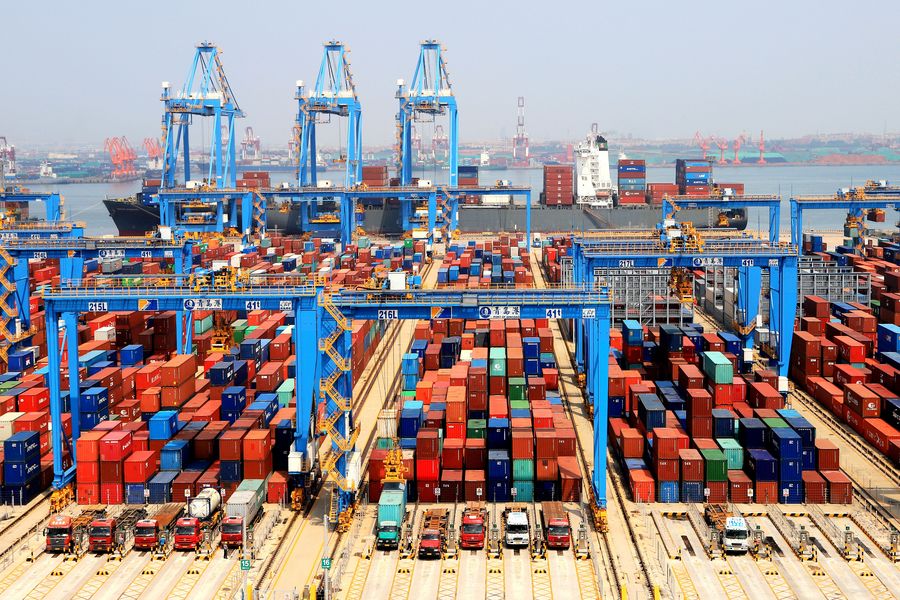
A screen displaying real-time coordinates of global vessels in Shanghai, China, August 12, 2018. /Xinhua
A screen displaying real-time coordinates of global vessels in Shanghai, China, August 12, 2018. /Xinhua
Editor's note: Wang Huiyao is the president of the Center for China and Globalization. The article reflects the author's views, and not necessarily those of CGTN.
The COVID-19 is still running rampant across the world. Experts warn there may be more waves before a vaccine is available.
The pandemic is causing a global recession. International organizations such as the World Bank's warning that it is also weakening multilateral cooperation. However, amidst growing tendencies towards de-globalization, China's continued deepening of reform and opening-up offers hope for the world economy.
That is due to the fact that, according to the National Bureau of Statistics of China, China's second-quarter GDP grew by 3.2 percent year-on-year. Besides, while the World Bank predicts that the world economy may shrink by 5.2 percent in 2020, China is the only major economy expected to achieve positive growth with one percent.
Furthermore, China's efforts to maintain global trade and cross-border investment will be a catalyst for the recovery of the world economy. The government firmly committed to opening-up, although there is a tendency as the U.S. and some other countries veer towards unilateralism and protectionism.
Since China's first negative list for foreign investment access was released in 2017, the list has been progressively shortened from 93 to 40 items. This year' Two Sessions signaled that China would continue to open its market and improve the business environment to attract more foreign direct investment.
Since May, a number of new opening-up measures have been implemented, such as the liberalization of foreign investment in financial services. On June 1, China released the Overall Plan for the Hainan Free Trade Port, including zero tariffs on specific goods, lower income tax rates, and a simplified tax system. Once operational, the Port will become another door opening for China to interact with the world.
Therefore, China's opening-up will not only benefit itself, but also brighten prospects for the world economy amid the current crisis. China, being a driving force for the global economy in recent years, has contributed more than 30 percent of global economic growth – such figure has exceeded the U.S.', the EU's and Japan's combined.

An automatic container dock in Qingdao, east China's Shandong Province, May 16, 2018. /Xinhua
An automatic container dock in Qingdao, east China's Shandong Province, May 16, 2018. /Xinhua
China has demonstrated its ability to accelerate global economic recovery during the 2008 financial crisis, and now, amidst the COVID-19 crisis, China is capable of helping the world move out of the coronavirus shadow via continued opening-up and multilateral cooperation.
Moreover, China's development can also contribute to global poverty alleviation which is one of the 17 sustainable development goals (SDGs) on the UN 2030 Agenda for Sustainable Development.
For example, the Belt and Road Initiative (BRI). According to a 2019 UN report, the number of people living in poverty actually increased in 2018, from 784 million in 2015 to 821 million. Experts point out that the BRI can help improve the situation to some extent.
A study by the World Bank has also found that the BRI could lift 7.6 million people out of extreme poverty and 32 million out of moderate poverty, and increase trade of participating countries by 2.8 percent to 9.7 percent, global trade by 1.7 percent to 6.2 percent, and global income by 0.7 percent to 2.9 percent.
Thirdly, employment in other countries will also be boosted by China's opening-up. According to a 2017 survey conducted by China Central Television and China Foreign Languages Publishing Administration, among 10,000 respondents worldwide, three out of 10 said they could gain employment opportunities offered by Chinese companies. So far, 102 Chinese state-owned enterprises (SOEs) have invested in 185 countries and regions around the world, creating 330,000 local jobs.
Meanwhile, BRI programs invested by Chinese companies have created more than 160,000 jobs. The World Bank estimates that China's outbound investment and import/export activities directly create 15 million jobs in other countries every year on average.
Openness and cooperation are valuable for building a more inclusive form of globalization and achieving sustainable development, which will benefit people around the globe. We should keep in mind that multilateral cooperation is the only way to address the global crisis and make globalization more open, inclusive, and beneficial to all.
(If you want to contribute and have specific expertise, please contact us at opinions@cgtn.com.)